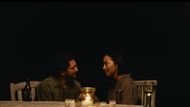What if the love of your life belonged to a different timeline? Past Lives doesn’t just ask that question; it lingers in it, breathes through it, and then quietly breaks your heart with it. Celine Song’s haunting debut wraps its final moments not in declarations or closure, but in a lingering silence between two souls who were never quite meant to stay, only to meet.
As Nora and Hae Sung share a goodbye that lets go of a hundred what-ifs, the film invites us to take a deep dive into the lives we live, the ones we leave behind, and the ones that might’ve been, if only fate had written them differently. Here's what the ending of Past Lives means.
What is Past Lives about?

Past Lives is a quiet storm of a film, the kind that sneaks up on you, then stays lodged in your chest long after the credits roll. Written and directed by Celine Song in her breathtaking debut, the story isn’t just about a romance lost to time; it’s about identity, memory, longing, and the haunting echo of what could’ve been.
At its heart are Nora and Hae Sung, two childhood friends in South Korea who are separated when Nora’s family emigrates to Canada. Over the years, they drift apart, only to find each other again as adults, first online, then in person, and are forced to confront the gravity of a connection that never quite died.
Now, Nora is a playwright in New York, married to a kind, gentle man named Arthur. Hae Sung is visiting from Seoul. And between them hangs a silence filled with all the things they never got to say.
But the film isn’t a love triangle. It’s something messier, more honest. It’s a meditation on the Korean concept of in-yun, the idea that people in this life are linked through countless past ones. And with that comes the devastating realization that not all connections are meant to be acted on. Some are just meant to be felt.
What is In-yun? What part does it play in Nora and Hae Sung's lives?

In Past Lives, the Korean idea of In-yun is way more than just some pretty concept, it’s really the heart of the whole story. It’s this belief that the people we meet, the connections we make, aren’t random at all. They’re like echoes from past lives, invisible threads pulling souls together across time and space.
There’s this really tender moment when Nora explains In-yun to Arthur as a montage plays in the background. It's a powerful scene, and one that kind of forms the backbone of the entire story.
"There is a word in Korean. In-Yun. It means “providence”. Or… “fate”. But it’s specifically about relationships between people. I think it comes from Buddhism and reincarnation. It’s an In-Yun if two strangers even walk by each other in the street and their clothes accidentally brush. Because it means there must have been something between them in their past lives. If two people get married, they say it’s because there have been 8,000 layers of In-Yun. Over 8,000 lifetimes."
Nora and Hae Sung’s story feels soaked in that magic. Years and oceans separate them; they’re living different lives, but somehow their paths keep crossing. It’s not just nostalgia or unfinished business. It’s In-yun reminding them their souls have been connected long before this life even started.
Does Nora end up with Hae Sung in the end?

No. Although the film shows how it's a possibility and a very likely future that they could have if they chose to be together, Nora eventually chooses her present over her past.
After a bittersweet dinner with Nora and her husband Arthur, Hae Sung heads back to their apartment and orders an Uber. Nora walks him to the pickup spot, and they share a long, silent gaze, full of meaning and memories.
When Hae Sung finally breaks the quiet, he wonders aloud if the life they’re living now might actually be a past life. He asks what kind of relationship they might have in the next one, and Nora tells him she has no idea. Hae Sung smiles and says, “I’ll see you then,” before getting on his ride and leaving for the airport.
This moment is a breath of fresh air after the movie’s emotional weight, a hopeful nod to the idea that some connections transcend time. Despite the distance and circumstances that keep them apart now, Hae Sung believes their souls will grow closer in the next life.

Back home, Nora breaks down in tears, not out of simple regret, but from the crushing complexity of saying goodbye to a love that never quite left her heart. It’s the ache of paths diverging, the guilt of moving on, and the bittersweet truth that life wrote their stories on separate pages. She loves Arthur deeply, no doubt there, but Hae Sung remains an indelible mark, a “what-if” that lingers in the spaces between her smiles.
How the ending of Past Lives signifies hope

The final scene of the film gently steers the story toward a note of hopeful possibility. Much of the narrative dwells on what might have been and the endless possibilities of what life would look like if one thing changed. But the ending shifts focus away from regret and toward what could be. Hae Sung’s quiet hope that they’ll be closer in the next life carries a beautiful optimism, even if that future feels far away.
Before visiting Nora in New York, Hae Sung clung to the fading hope that this lifetime might still hold a chance for them. But after seeing Nora’s happiness with Arthur and realizing Arthur is a good man, Hae Sung accepts their relationship can only be a long-distance friendship, for now.
Instead of giving up, he channels his hope into the next life, reminding us all that no matter the odds, there’s always a glimmer of hope to hold onto.
Past Lives is available to stream on Prime Video.
Love movies? Try our Box Office Game and Movie Grid Game to test your film knowledge and have some fun!
